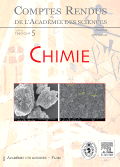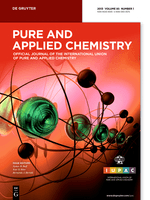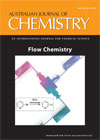
Chemistry Africa-A Journal of the Tunisian Chemical Society
Scope & Guideline
Illuminating the Path of Chemical Discovery
Introduction
Aims and Scopes
- Environmental Chemistry and Pollution Control:
Research involves the study of pollutants, their sources, and their impact on the environment, particularly in Africa. This includes studies on heavy metal contamination, wastewater treatment, and the development of sustainable remediation techniques. - Medicinal Chemistry and Pharmacology:
The journal publishes studies on the discovery and development of pharmaceutical compounds derived from natural products, with a strong emphasis on traditional medicinal plants and their potential therapeutic effects. - Nanotechnology and Materials Science:
Research on the synthesis and application of nanomaterials for environmental and biological purposes, including their use in drug delivery, biosensing, and as catalysts for chemical reactions. - Green Chemistry and Sustainable Practices:
The journal encourages research that focuses on eco-friendly methods for chemical synthesis and the use of renewable resources, promoting sustainable practices in chemistry. - Analytical Chemistry and Method Development:
Studies that develop and optimize analytical techniques for the detection and quantification of chemical substances in various matrices, including food, water, and biological samples.
Trending and Emerging
- Biotechnology and Natural Products:
There is a growing trend in the exploration of natural products for pharmaceutical applications, driven by the rich biodiversity in Africa. Studies focus on the phytochemical analysis and bioactivity of indigenous plants. - Environmental Remediation Technologies:
Innovative methods for addressing environmental pollution, such as the use of biochar, nanomaterials, and bioremediation techniques, are increasingly featured as solutions to combat pollution challenges. - Computational Chemistry and Drug Design:
The integration of computational methods in drug discovery is on the rise, with researchers employing molecular docking and dynamics simulations to identify potential therapeutic agents. - Waste Valorization and Resource Recovery:
Research on converting agricultural and industrial waste into valuable products, such as biofuels and adsorbents, is emerging as a key area, aligning with global sustainability goals. - Sustainable and Green Chemistry Practices:
There is an increasing focus on developing eco-friendly chemical processes and materials, highlighting the importance of sustainability in chemical research.
Declining or Waning
- Traditional Synthetic Methods:
Research focused on conventional chemical synthesis techniques is becoming less prominent as the field shifts towards more innovative and sustainable approaches, such as green chemistry. - Non-Biological Catalysts:
The interest in non-biological catalysts is declining as researchers increasingly explore biocatalysis and enzyme-based methods for chemical reactions, particularly in sustainable practices. - Basic Chemical Education:
There is a noticeable reduction in publications dedicated to basic chemical education, possibly due to a greater emphasis on research that directly addresses real-world problems and applications.
Similar Journals

BMC Chemistry, published by BMC, is a reputable open access journal that has made significant strides since its inception in 2019. Operating under e-ISSN 2661-801X, this journal is dedicated to advancing the field of general chemistry by promoting high-quality research across various sub-disciplines. Headquartered in the United Kingdom, BMC Chemistry boasts a commendable impact factor and is classified in Q2 within the prestigious field of Chemistry (miscellaneous) according to the 2023 category quartiles. The journal's Scopus ranking places it at #139 out of 408 in its category, highlighting its growing relevance and influence in the academic community, with a commendable 66th percentile standing. With a commitment to open access, BMC Chemistry ensures that groundbreaking discoveries and innovative research are available to a global audience, fostering collaboration and development in chemistry. Researchers, professionals, and students alike will find this journal to be an invaluable resource for disseminating knowledge and driving scientific advancement.

Canadian Journal of Chemistry
Uniting Scholars for a Brighter Chemical FutureWelcome to the Canadian Journal of Chemistry, a prominent publication dedicated to advancing the study of chemistry through original research and critical reviews. Published by Canadian Science Publishing, this journal has been a cornerstone of chemical research since its inception, covering a broad spectrum of topics within the field, including catalysis, organic chemistry, and general chemistry. With an ISSN of 0008-4042 and E-ISSN of 1480-3291, it provides a vital platform for researchers, professionals, and students to disseminate their findings and engage in scholarly discourse. Impact Factor is currently in development, with the journal classified in the Q4 category for catalysis and Q3 for miscellaneous chemistry fields, signifying its evolving contributions to the scientific community. The journal operates without an open access model, which ensures a rigorous peer-review process while maintaining subscription access for institutions and libraries. Located in Ottawa, Canada, the Canadian Journal of Chemistry continues to provide an invaluable resource for those dedicated to the scientific pursuit of chemistry, making significant strides in fostering interdisciplinary approaches and innovative research methodologies.

Nature Reviews Chemistry
Your Gateway to Cutting-Edge Chemical DiscoveriesNature Reviews Chemistry is a premier journal published by NATURE PORTFOLIO, dedicated to advancing scholarly discourse in the broad field of chemistry. With an impressive impact factor and a ranking in the 99th percentile across its categories—ranked #2 in General Chemical Engineering and #4 in General Chemistry according to Scopus—this journal is recognized for its high-quality, peer-reviewed articles that synthesize and analyze the latest advancements in chemical research. Operating under a convergence framework from 2017 to 2024, Nature Reviews Chemistry aims to provide comprehensive insights and critical examinations of contemporary chemical practices, thereby reinforcing its status as a vital resource for researchers, professionals, and students alike. Although it is not an open-access journal, the breadth and authority of its content make it essential for those looking to stay at the forefront of chemical sciences.

COMPTES RENDUS CHIMIE
Fostering Global Collaboration in Chemical Sciences.COMPTES RENDUS CHIMIE, published by the prestigious Académie des Sciences in France, stands as a significant journal in the fields of chemistry and chemical engineering. With an ISSN of 1631-0748 and an E-ISSN of 1878-1543, this open-access journal has been committed to disseminating high-quality research since its transition to open access in 2020. Featuring a diverse array of studies, the journal covers innovative research trends and applications, while maintaining a Q3 category ranking in both Chemical Engineering (miscellaneous) and Chemistry (miscellaneous) as of 2023. Its Scopus rankings, positioning at #251 out of 408 in general chemistry and #169 out of 273 in general chemical engineering, highlight its growing impact within the scientific community. Authored by a global cohort of scientists and researchers, COMPTES RENDUS CHIMIE is dedicated to the advancement of knowledge and sharing insights that are vital for ongoing research and development in the chemical sciences. Located in the heart of Paris at 23 Quai de Conti, 75006, France, the journal is an essential resource for those passionate about chemistry and engineering disciplines, fostering collaboration and innovation across the world.

Moscow University Chemistry Bulletin
Empowering the Next Generation of ChemistsMoscow University Chemistry Bulletin is a distinguished academic journal dedicated to advancing the field of chemistry, published by PLEIADES PUBLISHING INC. With an ISSN of 0027-1314 and an E-ISSN of 1935-0260, this journal provides a platform for researchers, professionals, and students to explore a wide range of topics in general and specialized chemistry. While it holds a current Q4 ranking in the “Chemistry (miscellaneous)” category according to Scopus, the journal is committed to broadening its scope and visibility, aiming for greater impact in the global scientific community. Moscow University Chemistry Bulletin focuses on the publication of cutting-edge research, reviews, and discussions that stimulate innovation and collaboration. Although it is not an Open Access journal, it plays a crucial role in disseminating knowledge and fostering academic dialogue within the field, as it converges towards significant findings from 2004 to 2024. The continuous development of its content holds the potential to attract a diverse readership, making it a valuable resource for those involved in the chemical sciences.

JOURNAL OF THE CHEMICAL SOCIETY OF PAKISTAN
Fostering Scientific Dialogue in Chemistry.JOURNAL OF THE CHEMICAL SOCIETY OF PAKISTAN is a premier academic journal published by the Chemical Society of Pakistan, focusing on advancing the field of chemistry through rigorous research and scholarship. Established in 1996, this journal aims to disseminate high-quality research articles, reviews, and insights pertaining to various subfields of chemistry, making substantial contributions to both local and international scientific communities. With a current impact factor placing it in the Q4 category, the journal continues to foster discussions on emerging trends and innovations within the discipline. Additionally, it holds a Scopus rank of #305 out of 408, highlighting its growing influence despite being positioned in the 25th percentile. Although it is not an open-access journal, it provides a crucial platform for researchers and professionals in Pakistan and worldwide. The JOURNAL OF THE CHEMICAL SOCIETY OF PAKISTAN serves as a valuable resource for students, educators, and industry professionals alike, facilitating the exchange of knowledge and promoting advancements in chemical sciences.

Natural Products and Bioprospecting
Connecting Nature and Science for Global ImpactNatural Products and Bioprospecting is a prestigious academic journal published by SPRINGERNATURE, dedicated to advancing research in the fields of analytical chemistry, biochemistry, plant science, organic chemistry, and pharmacology. With an impact factor that positions it within the top quartiles across multiple categories, this journal serves as a crucial platform for disseminating groundbreaking findings and innovative methodologies focusing on the potential of natural products. Since adopting its Open Access model in 2011, it has broadened its reach, allowing global accessibility to cutting-edge research. The journal, based in Singapore, aims to foster interdisciplinary collaboration and encourages submissions that explore the intricate relationships between natural products and their applications in food science, toxicology, and pharmacology. Its well-respected status is further highlighted by impressive Scopus ranks and a growing H-index, reinforcing its significance in the scientific community. Researchers, professionals, and students alike can benefit from the rich repository of knowledge that Natural Products and Bioprospecting continuously curates and disseminates, making it an invaluable resource in the quest for innovative solutions derived from nature.

PURE AND APPLIED CHEMISTRY
Exploring Innovations in Chemical EngineeringPURE AND APPLIED CHEMISTRY is a highly regarded journal in the fields of chemical engineering and general chemistry, published by Walter de Gruyter GmbH. Since its inception in 1960, this journal has continued to foster advancements in chemical research and facilitate the dissemination of new knowledge through its rigorous peer-reviewed articles. With an impressive impact factor that places it in Q2 quartile rankings for both Chemical Engineering and Chemistry as of 2023, it holds a significant position in the academic landscape, attracting authors and contributors from around the globe. The journal’s unique focus on the practical applications of chemical research makes it indispensable for researchers, professionals, and students aiming to bridge theoretical knowledge with real-world applications. Although it is not open access, its impact is enhanced by its continued relevance and contributions to the ever-evolving field of chemistry. Researchers and practitioners alike will find in PURE AND APPLIED CHEMISTRY a critical resource for staying updated on key developments and innovative practices in chemistry and chemical engineering.

CHEMICAL JOURNAL OF CHINESE UNIVERSITIES-CHINESE
Nurturing a Community of Chemistry Innovators.CHEMICAL JOURNAL OF CHINESE UNIVERSITIES-CHINESE, published by Higher Education Press, serves as a vital platform for advancing research in the field of chemistry. With a history dating back to 1996, this journal has evolved to encompass a wide range of topics fundamental to the chemistry community, catering to both applied and theoretical perspectives. Although classified in Quartile 4 within the broader chemistry category, it remains a significant contributor to the knowledge base, ranking 281st out of 408 journals in the general chemistry category according to Scopus. Positioned in Beijing, China, the journal aims to foster collaboration among researchers and professionals while disseminating innovative research and developments. By promoting open exchange of ideas in chemistry, it strives to elevate the scholarly dialogue and contribute to ongoing education for students and professionals alike, with its content accessible through institutional subscriptions.

AUSTRALIAN JOURNAL OF CHEMISTRY
Fostering global collaboration in chemical sciences.The Australian Journal of Chemistry, with an ISSN of 0004-9425 and an E-ISSN of 1445-0038, is a distinguished publication from CSIRO PUBLISHING, dedicated to advancing the field of chemistry since its inception in 1948. Based in Australia, this journal serves as a platform for original research articles, reviews, and innovative studies that encompass a wide spectrum of chemical disciplines, aiming to foster communication and collaboration among researchers globally. Despite its Q3 ranking in the Chemistry (Miscellaneous) category and standing at rank #236 in Scopus’ general chemistry classification, it remains an essential resource for professionals and students seeking to stay informed about emerging trends and discoveries in chemistry. The journal does not offer open access, emphasizing the premium quality of peer-reviewed content that adheres to rigorous academic standards. By bridging theory and practice, the Australian Journal of Chemistry continues to play a crucial role in shaping the future of chemical sciences.